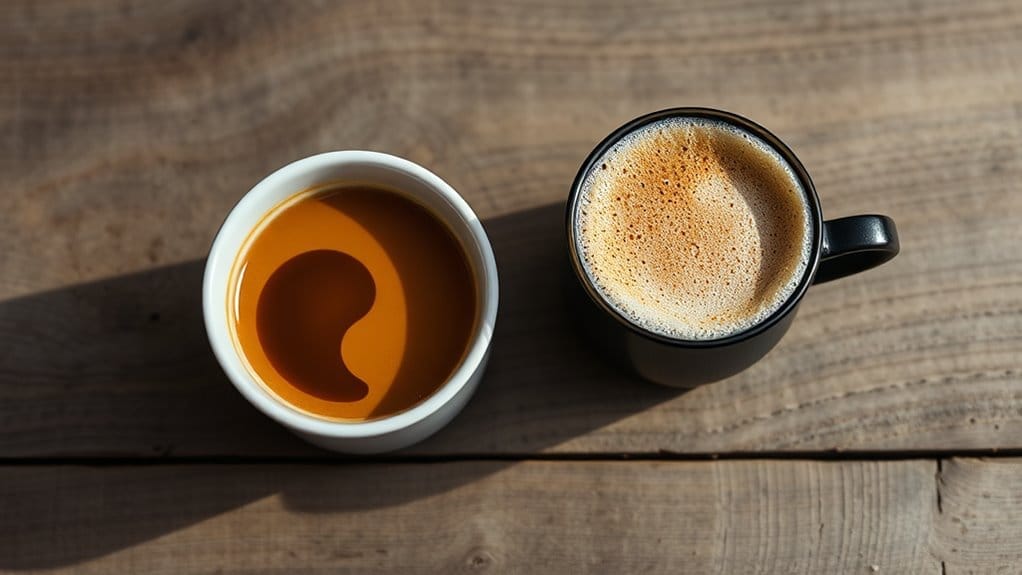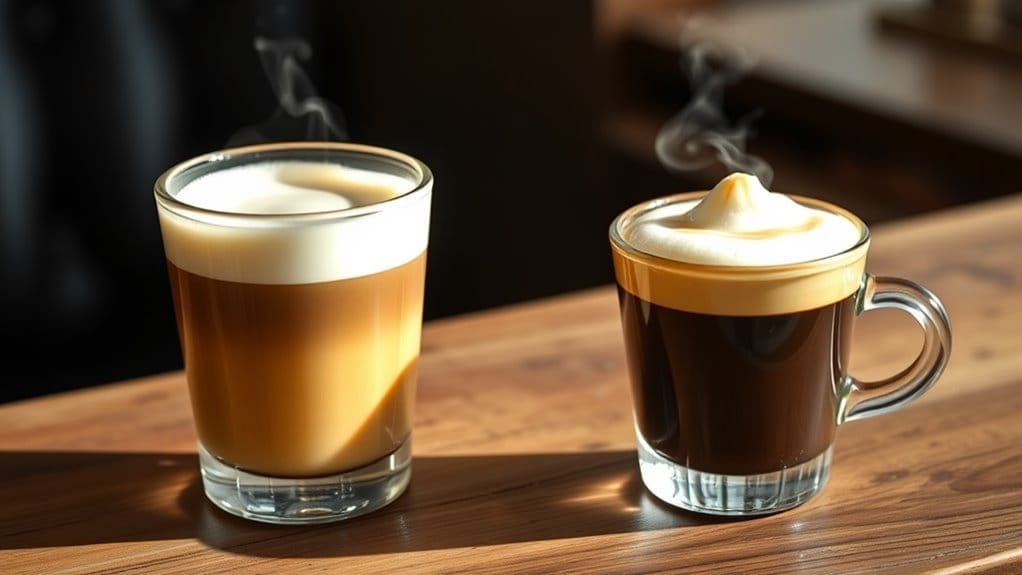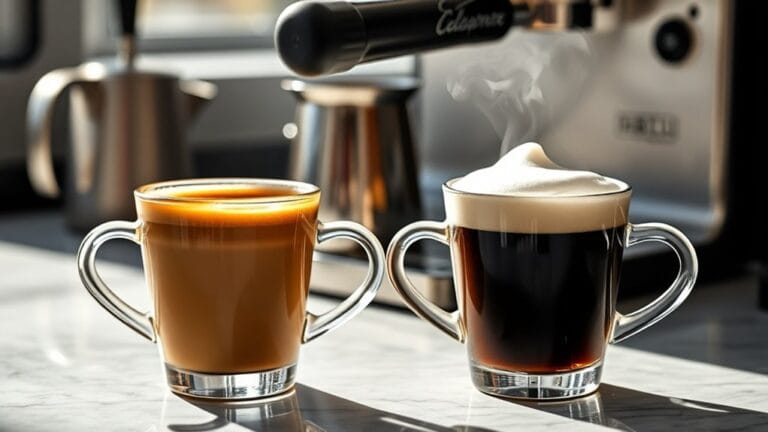Cortado, from Spain, mixes espresso with warm, silky milk in equal parts, like a bear hug for coffee bitterness. Macchiato, Italy’s answer, is a bold espresso “stained” by a milk-foam dollop, perfect for espresso fans wanting a wink of creaminess. Smooth vs. sharp, steamed vs. foamed milk, 4-ounce glass vs. tiny cup—these drinks showcase culture in a cup. Their flavors sway from nutty mellow to intense roast. Let’s spill the beans on these coffee cousins.
Origins and Cultural Backgrounds
The cortado and macchiato share espresso roots but tell wildly different origin stories.
Born in Spain’s Basque Country in the 1960s, the cortado—from “cortar,” meaning “to cut”—softens espresso’s bite with equal parts steamed milk, creating a social, balanced drink for café-goers. The cortado’s 2010 New York Times Magazine spotlight catapulted it into American coffee culture, making it a fixture in third-wave cafes from Brooklyn to San Francisco.
Meanwhile, the Italian macchiato (“stained”) emerged as a quick espresso shot “marked” by a dollop of milk foam, perfect for bustling bars where drinkers stand, sip, and dash.
Spain’s cortado spread globally as a smooth, midday treat, while Italy’s macchiato became a go-to for espresso purists craving just a creamy whisper.
Both drinks reflect their homelands: one rebels against bitterness, the other champions coffee’s raw power, proving even tiny sips can carry big cultural energy.
Composition and Coffee-to-Milk Ratio
Imagine espresso and milk in a tug-of-war—cortado and macchiato settle the match differently.
The cortado plays fair, splitting the spotlight: 1:1 ratio of espresso to steamed milk, balancing bold coffee with creamy sweetness. Picture a roughly 4-ounce drink, two parts espresso, two parts silky milk, blending smooth sips with mellow flavors. Traditionally using Robusta beans for intense flavor, many modern cafés opt for Arabica, softening its earthy edge. This drink emphasizes maintaining strong coffee flavor while still offering a creamy balance, making it a favorite among those who appreciate the fusion of textures. The perfectly balanced cortado is optimized for immediate consumption, served at a temperature that enhances its flavors.
The macchiato? Let’s call it espresso’s victory lap—a 1-ounce shot “stained” by a mere teaspoon of foam, barely enough milk to whisper “hello.” Its tiny size (under 2 oz total) shouts espresso’s strength, sharp and intense, softened just a hair by foam.
Cortado drinkers crave harmony, macchiato fans want drama. Which side wins? Depends if you’re team “coffee with milk” or “milk? What milk?” Choose your corner, or switch-hit—liberty’s delicious here.
Milk Preparation Techniques: Steamed vs. Foamed

While espresso takes center stage, the real magic in drinks like cortados and macchiatos comes from how milk gets prepped—steamed or foamed, each method wildly different.
Steamed milk is heated with pressurized steam, creating silky-smooth microfoam with tiny bubbles that blend seamlessly into espresso, like in a cortado’s creamy balance.
Foamed milk, though, traps more air, making larger, fluffier bubbles that sit atop espresso like a cloud, seen in a macchiato’s bold “stain.”
Steam’s heat stays lower (120-140°F), keeping milk proteins intact for that velvety feel, while foam hits higher temps (160-180°F), thinning the milk so it floats.
Steaming crafts latte-ready texture; foaming builds structured peaks.
Pick steamed for harmony, foamed for contrast—no rules, just flavor freedom.
Flavor Profile and Strength Comparison
Steamed milk in cortados and foamed milk in macchiatos do more than change texture—they shape each drink’s personality.
Cortados, blending equal parts espresso and steamed milk, deliver smoothed-out flavors of nutty caramel, like coffee wearing a cozy sweater. This is enhanced by the bean density of the espresso, which influences the roasting time and ultimately the drink’s creamy profile.
Macchiatos punch harder, letting bold espresso—with dark chocolate vibes—shine through a dollop of foam, perfect for those craving a caffeine jolt in disguise. The specific origin of the espresso beans also plays a crucial role in determining the overall flavor intensity.
Strength-wise, macchiatos lean intense, their lower milk ratio sharpening espresso’s edge, while cortados mellow things into creamy harmony.
Spain’s balanced sipper vs Italy’s espresso-forward kick: one whispers “relax,” the other shouts “let’s go!”
Whether you crave sweetness without surrender or espresso that bites back, these drinks cater to coffee rebels and comfort-seekers alike. Espresso bean characteristics directly influence the flavor profiles, enhancing each drink’s unique qualities.
Serving Styles and Presentation Differences

Although their espresso hearts beat strong, cortados and macchiatos dress differently for the spotlight. Cortados arrive in squat 4-ounce glasses, letting drinkers admire creamy steamed milk blending with espresso like coffee-colored watercolors. Macchiatos, served in tiny 1-2-ounce demitasse cups, punch harder with dark espresso barely touched by a foamy white “stain” on top. The cortado’s smooth, layered look invites slow sipping, while macchiatos deliver bold contrast—espresso’s intensity front-and-center. Both drinks use milk like makeup, but cortados blend it in, and macchiatos dab it on for flair.
| Aspect | Cortado | Macchiato |
|---|---|---|
| Vessel | 4-ounce glass, often with a sleeve | 1-2-ounce espresso cup |
| Milk Style | Steamed, silky | Foamy dollop |
| Visual Mood | Calm gradient, balanced | Stark contrast, espresso-forward |
The cortado’s glass feels casual, cafe-ready for midday pauses, while the macchiato’s cup means business—quick, sharp, no-nonsense.
Frequently Asked Questions
Which Drink Typically Contains More Caffeine: Cortado or Macchiato?
Cortado generally contains more caffeine, using two espresso shots (around 128 mg) versus macchiato’s single shot (85 mg). Milk ratios affect intensity, but standard preparation prioritizes espresso volume as the primary caffeine determinant.
Can Cortados or Macchiatos Be Made With Non-Dairy Milk Alternatives?
Both cortados and macchiatos can incorporate non-dairy milk alternatives like oat, soy, or almond varieties. Textural differences may arise with plant-based milks due to reduced foaming capacity while preserving essential espresso-forward profiles.
Which Beverage Is Better Suited for Someone With Lactose Intolerance?
Macchiatos suit lactose intolerance better due to minimal milk. Cortados have higher lactose content from steamed milk. However, both can use non-dairy alternatives. Choice depends on milk quantity tolerance and preference for bold coffee flavor.
How Do Cortados and Macchiatos Compare in Terms of Calorie Content?
In the balance of cream and coffee intensity, cortados (37-59 calories) eclipse macchiatos (5-25) due to steamed milk’s richness. Both vary with milk type, yet macchiatos’ minimalist foam maintains caloric restraint without sacrificing espresso essence.
Can Either Drink Be Served Iced or as a Cold Beverage?
Both drinks can be served iced. Cortados use equal parts espresso and milk poured over ice, while macchiatos layer espresso shots over cold milk or ice, maintaining their distinct ratios and textures in cold preparations.
References
- https://homecoffeeexpert.com/cortado-vs-macchiato/
- https://coffeehero.com.au/blogs/news/the-difference-between-a-cortado-and-a-macchiato
- https://methodicalcoffee.com/blogs/coffee-culture/macchiato-vs-cortado-vs-flat-white-whats-the-difference
- https://majestycoffee.com/blogs/posts/cortado-vs-macchiato-vs-latte
- https://www.crukafe.com/en-us/blogs/news/macchiato-cortado
- https://www.baristamagazine.com/misunderstood-coffee-drinks-the-cortado/
- https://www.oddbeans.in/blogs/news/what-is-cortado
- https://www.luxcafeclub.com/blogs/news/macchiato-revealed-tracing-the-roots-of-a-coffee-legend
- https://www.historyoasis.com/post/origin-coffee-types
- https://espressoinsiders.com/coffee-info/cortado-vs-macchiato-which-to-choose/





